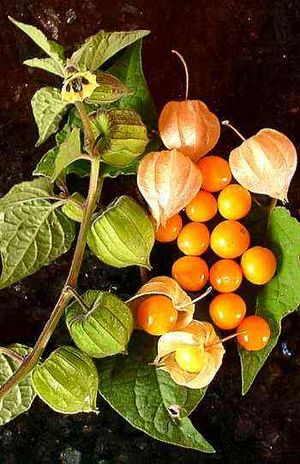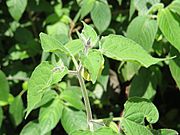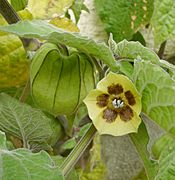Physalis peruviana facts for kids
Quick facts for kids Physalis peruviana |
|
|---|---|
 |
|
| Ripe orange fruits | |
| Scientific classification | |
| Genus: |
Physalis
|
| Species: |
peruviana
|
| Synonyms | |
|
|
The Physalis peruviana is a cool plant from South America, especially Colombia, Ecuador, and Peru. It belongs to the nightshade family, which is called Solanaceae. You might know it better by its common names like Cape gooseberry or goldenberry. In its home countries, people call it aguaymanto, uvilla, or uchuva. In Hawaii, it's known as poha, and in Egypt, it's called Harankash. It also has many other local names! Sometimes, it's even called a ground cherry.
People in the Inca Empire were growing P. peruviana a long, long time ago. It came to England in the late 1700s and to South Africa (near the Cape of Good Hope) by the early 1800s. Now, you can find P. peruviana growing all over the world in both warm and mild climates.
Contents
What's in a Name?
The famous scientist Carl Linnaeus officially named Physalis peruviana in 1763.
This plant was grown in England by 1774. Early settlers at the Cape of Good Hope in South Africa were growing it before 1807. We don't know if it was there before England, but people started calling it "Cape gooseberry" because it was popular in that region. Some people think the "cape" part of the name might come from the papery husk that covers the fruit, like a little cape!
Even though it's called a "gooseberry," it's not actually related to the true gooseberry plants, which are in the genus Ribes.
P. peruviana has many different names around the world. For example, in Peru, it's called aguaymanto in Spanish or topotopo in the Quechua language. In nearby Colombia, it's known as uchuva. In China, people sometimes call it deng long guo, which means "lantern fruit." In French, it has lovely names like amour en cage ("love in a cage") or cerise de terre ("ground cherry").
Meet the Plant
P. peruviana is a close relative of the tomatillo. Since it's part of the Solanaceae plant family, it's also related to many other foods you eat, like tomatoes, eggplants, and potatoes.
In places with cold winters, P. peruviana grows for only one year, like an annual plant. But in warm, tropical areas, it can live for many years, like a perennial plant. When it grows as a perennial, it becomes a bushy plant, usually about 1 to 1.6 meters (3 to 5 feet) tall. It has soft, heart-shaped leaves.
The flowers are bell-shaped and hang down. They are about 1.5 to 2 centimeters (0.6 to 0.8 inches) wide and are yellow with purple-brown spots inside. After the flower falls off, a part called the calyx grows bigger. This calyx turns into a light brown, papery husk that completely covers the fruit.
The fruit itself is a small, round, smooth berry. It looks like a tiny yellow tomato, about 1.25 to 2 centimeters (0.5 to 0.8 inches) wide. When you take it out of its husk, it's bright yellow to orange. When it's ripe, it tastes sweet with a slightly tart flavor, a bit like grapes or tomatoes.
The most interesting part is that inflated, papery husk (the calyx) that surrounds each berry. This husk grows bigger as the fruit grows, protecting it. If you leave the fruit inside its husk, it can stay fresh at room temperature for about 30 to 45 days! The husk itself is not edible.
 |
|
| Nutritional value per 100 g (3.5 oz) | |
|---|---|
| Energy | 222 kJ (53 kcal) |
|
11.2 g
|
|
|
0.7 g
|
|
|
Protein
|
1.9 g
|
| Vitamins | Quantity
%DV†
|
| Vitamin A equiv. |
5%
36 μg |
| Thiamine (B1) |
10%
0.11 mg |
| Riboflavin (B2) |
3%
0.04 mg |
| Niacin (B3) |
18%
2.8 mg |
| Vitamin C |
13%
11 mg |
| Minerals | Quantity
%DV†
|
| Calcium |
1%
9 mg |
| Iron |
8%
1 mg |
| Phosphorus |
6%
40 mg |
|
Link to USDA Database entry
|
|
| †Percentages estimated using US recommendations for adults. | |
Where It Grows
The Physalis peruviana originally comes from the Andes Mountain regions of Chile, Colombia, and Peru. It likes to grow in forests, at the edges of forests, and near rivers. In its native home, it grows high up, from about 500 to 3000 meters (1,600 to 9,800 feet) above sea level. However, in places like Oceania and the Pacific islands, it can grow right at sea level in warm, mild conditions.
This plant can grow in many different places, from about 45°S to 60°N latitude, and from sea level up to 3000 meters (9,800 feet) high. In some natural areas, especially in Hawaii and other Pacific islands, it has become an invasive species. This means it grows very quickly and can take over areas, forming thick bushes.
Scientists believe there are many different types of this plant around the world. These types vary in plant size, husk shape, and the size, color, and taste of their fruit.
How It's Grown
The Cape gooseberry is now grown in many tropical, subtropical, and mild places like Australia, China, India, Malaysia, and the Philippines. It grows best when the average yearly temperature is between 13 and 18°C (55 and 64°F), but it can handle temperatures up to 30°C (86°F). It also does well in Mediterranean climates. It can survive some cold, but frost can damage it.
It needs good rainfall, from 800 to 4300 mm (31 to 169 inches) per year, as long as the soil drains water well. It prefers full sun or partial shade and grows strongly in sandy soil.
It's easy to grow this plant from seeds. Each fruit has many seeds (100 to 300!), but not all of them sprout. You might need thousands of seeds to plant a large area. You can also grow new plants from stem cuttings that are a year old. These plants will flower sooner and produce a good harvest, but they might not be as strong as plants grown from seeds.
Plant Problems
Like all plants, the Cape gooseberry can have problems with pests and diseases. In South Africa, tiny worms called cutworms can attack young plants. Red spiders and potato tuber moths can also be a problem. Hares (like rabbits) might nibble on young plants, and birds enjoy eating the fruits. Other tiny pests like mites, whiteflies, and flea beetles can cause issues. Diseases like Powdery mildew, soft brown scale, root rot, and viruses can also affect the plants.
Eating the Fruit
The P. peruviana fruit is a valuable crop because it's an interesting fruit that many countries export. It's popular in plant breeding programs. In the United States, these fruits are sold as goldenberry and sometimes Pichuberry. The name "Pichuberry" links the fruit to Machu Picchu in Peru, where it originally came from.
Cape gooseberries are used to make many yummy things like fruit sauces, pies, puddings, chutneys, jams, and ice cream. You can also eat them fresh in salads and fruit salads. In Latin America, people often blend them into a batido or smoothie. Because of its pretty husk, it's often used in restaurants as a fancy decoration for desserts.
Scientists have studied the fruit as it ripens. They found that the amount of healthy compounds like polyphenols and vitamin C changes depending on the type of plant, when it's picked, and how ripe it is.
How Healthy Is It?
According to the USDA, a 100-gram serving of Cape gooseberries doesn't have a lot of food energy (about 222 kJ or 53 kcal). However, it has good amounts of vitamin C, thiamin (a B vitamin), and niacin (another B vitamin). Other nutrients are present in smaller amounts.
Scientists have also looked at the oil from different parts of the berry, especially its seeds. They found that the main fats are linoleic acid and oleic acid. The oil also contains important plant compounds called beta-sitosterol and campesterol, as well as vitamin K and beta-carotene (which your body turns into Vitamin A).
See also
 In Spanish: Uchuva para niños
In Spanish: Uchuva para niños





